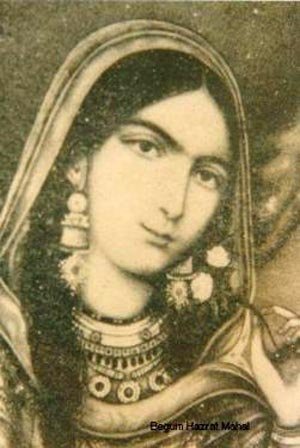
Hazrat Mahal was a queen of the deposed Wajid Ali Shah. After the Indian victory at Chinhut on July 30, 1857, when Oudh’s forces captured Lucknow, the royal insignia was borne with amazing courage by the Begum. She crowned her minor son, Brijis Qadar, as King and became his Regent.
Unlike Rani Lakshmi Bai Jhansi, the Begum had a different beginning to her career she was brought up in a manner suitable only for a life of luxury and gay abandon. Her obvious place was in the royal harem of an extraordinary king, essentially a poet, musician and a connoisseur of beauty.
Before enthroning Brijis Qadar, the victorious soldiers had approached other Begums of Wajid Ali Shah (then a captive at Calcutta) to provide them their King. None of them ventured to come forward. Begum Hazrat Mahal readily consented to crown her ten-year-old son, Birjis Qadar, as King.
The Begum headed a government with top rebel leaders in key positions, under whose banner the different sections of the soldiers to form a united front. For about ten months the revolutionary government held the city of Lucknow.
During all these operations the Begum was obviously the Supreme Commander. Under the seal of King Brijis Qadar, she issued proclamations to the people in general, and to the Zamindars and Taluqdars in particular, to unite under the banner of the new government to fight the British. She was in direct correspondence with Nana Saheb and with some of the noble and time honoured Taluqdar and zamindar families, who actively participated in the investiture of the Residency and later in the battles of Lucknow. Amoung her important associates were Raja Beni Madho Baksh of Baiswara, Raja Dig Bijai Singh of Mahona, Khan Ali Khan of Shahjahanpur, Maulvi Ahmadullah Shah of Faizabad, Raja Man Singh and Raja Jaylal Singh.
To fortify Lucknow against advancing relief forces of the British, she sanctioned five lakhs of rupees to ‘have a wall built around the city’. When she was informed that the British had purchased the friendship of Rana Jung Bahadur of Nepal with the promise of Gorakhpur and a share of Oudh she immediately made the Rana a counter-offer of “Gorakhpur. Azamgarh, Arrah, Chapra and the province of Banaras, if he would unite with her”. She contacted the officers of the Indian regiments serving the British at Kanpur and settled with them that, when they were to face the begum’s forces, “the regiments should fire blank ammunitions” and afterwards “turn upon the Europeans”. On February 25, 1858, she appeared in the field on elephant back to supervise defence operation.
After the British capture of Lucknow, the Begum was listed No.1 of the enemies still at large. From Lucknow she retired with a large following across the river Ghagra and posted herself in the fort of Baundi in Bahraich district. A correspondent of the Government reported: “…a force is encamped on all sides of the fort, numbering about 15,000 or 16,000, including followers. Among these there are 1,500 cavalry and 500 mutineer sepoys, the rest are nujeebs and followers.”
While the British were busy in re-establishing their authority in Lucknow, the Begum once again succeeded in stirring the rest of Oudh in rebellion. In 1858, there were sporadic outbursts in different area of Oudh where the British experience some of the toughest encounters.
After Queen Victoria’s Proclamation, the British wanted to win the Begum over by offers of royal clemency and even a pension. The Begum replied with a counter proclamation under the seal of King Brijis Qadar, warning the people of Oudh not to be misled by false promises. The Begum’s Proclamation, as it is called, stated :
“At this time, certain weak-minded, foolish people have spread a report that the British have forgiven the faults and crimes of the people of Hindostan; this appears very astonishing, for it is the unvarying custom of the British never to forgive a fault, be it great or small; so much so that a small offence, committed through ignorance, they never forgive…Therefore we, the ever abiding government, parents of the people of Oudh, with great consideration put forth the present Proclamation in order that the real object of the chief points may be exposed and our subjects be placed on their guard.”
The Begum was determined not to fall into the hands of the British. Leaving the fort of Baundi in December 1858, she wandered in the dense jungle of the sub-Himalayan terai. Accompanied by a few faithful, ‘half-armed, half-fed and without artillery’ she continued to elude the British. Ultimately she crossed over to Nepal (some time in the last quarter of 1859) where she was given refuge by the King of Nepal despite British protests.
The Begum died in 1874 at Kathmandu.
